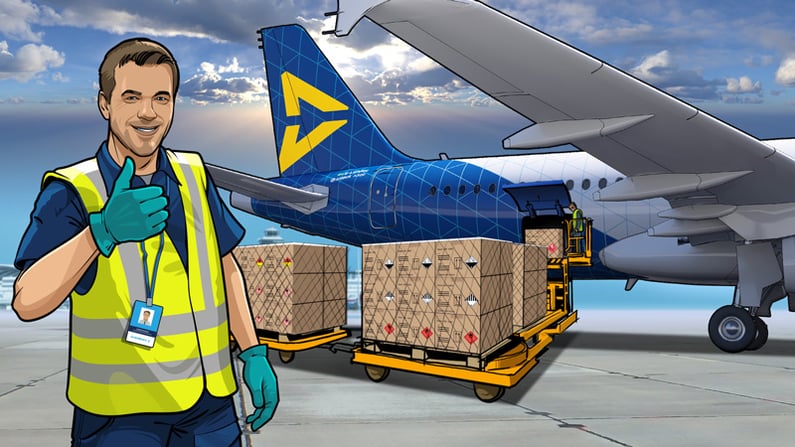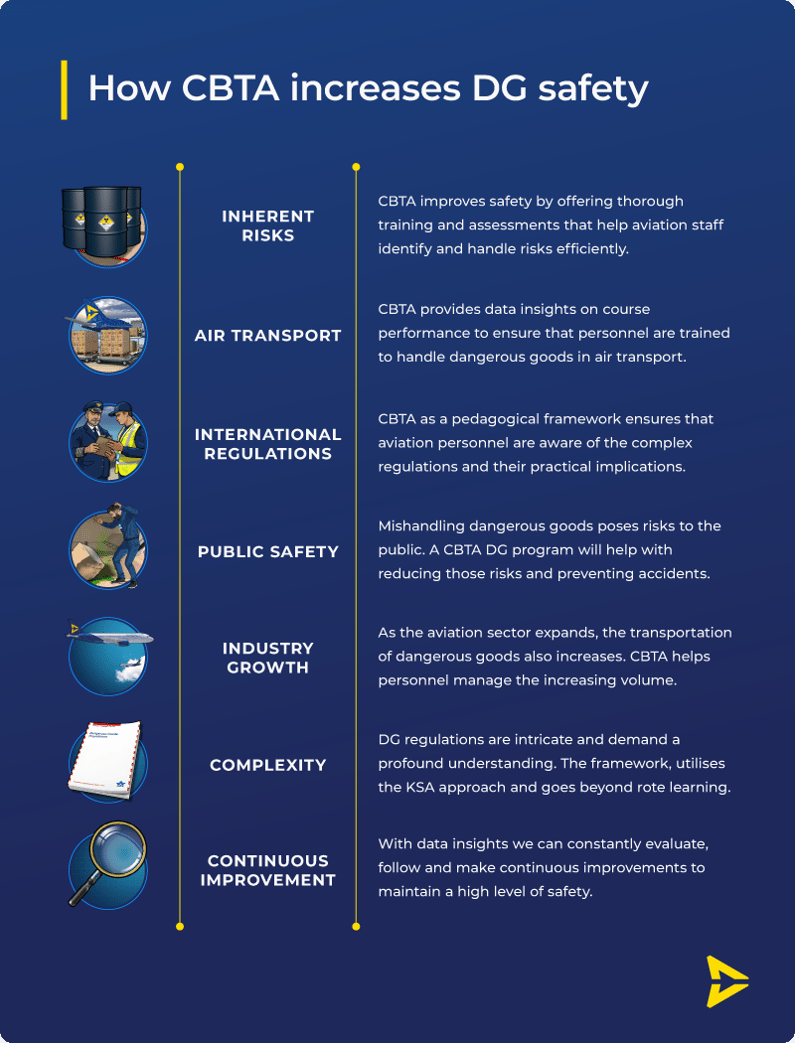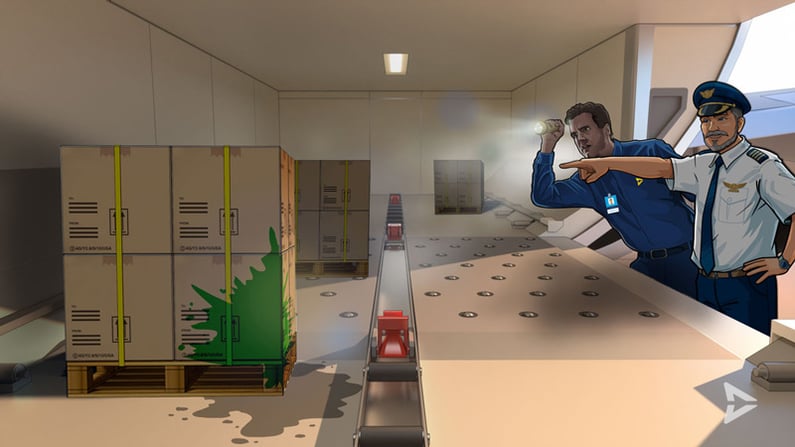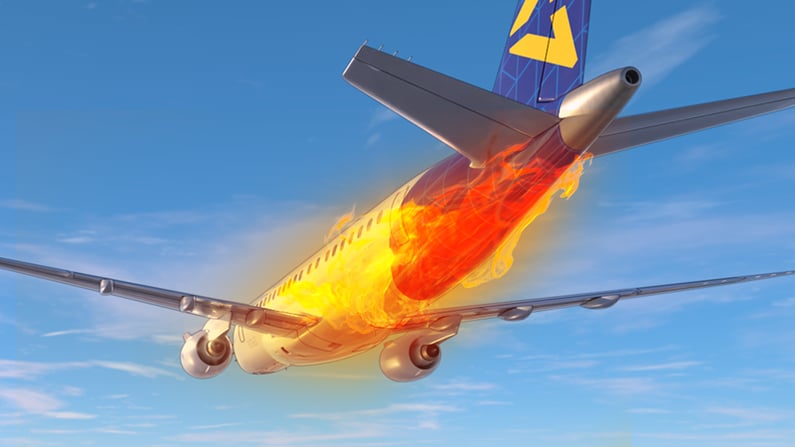
The brief response is that ICAO regulations have mandated a new training framework for Dangerous Goods, that went into effect on January 1st, 2023.
The long answer is that due to the increased safety measures required for every aviation operating organisation, the protocols for transporting dangerous goods is extremely important because of the hazardous risks posed if mishandled.
We all understand the risks dangerous goods, so it is important that this training is taken seriously. Here's why DG training is such a crucial topic, and how CBTA increases safety with data insights and assessments.

- Inherent Risks: Dangerous Goods (DG) encompasses a broad range of materials, including chemicals, explosives, and flammable substances. These items inherently carry risks. CBTA improves safety by offering thorough training and assessments that help aviation staff identify and handle risks efficiently.
- Air Transport: Operators frequently transport dangerous goods by air which comes with risks. CBTA provides data insights on course performance to ensure that aviation personnel are trained to handle dangerous goods in air transport.
- International Regulations: The transport of dangerous goods is subject to complex international regulations. CBTA as a pedagogical framework ensures that aviation personnel are not only aware of these regulations but also understand their practical implications, thereby promoting compliance and safety.
- Public Safety: Mishandling dangerous goods poses risks to the public. A CBTA DG program that focuses on assessing safety rules and procedures according to your operational requirements will help with reducing those risks. Its purpose is to keep the public safe and prepare aviation staff to prevent accidents.
- Industry Growth: As the aviation sector expands, the transportation of Dangerous Goods (DG) also increases. CBTA plays a pivotal role in maintaining air safety by providing personnel with a highly effective learning framework. This enhanced training framework will help that aviation personnel confidently manage the increasing DG volume, keeping the airspace safer for global travel and trade.
- Complexity: DG regulations are intricate and demand a profound understanding. The CBTA framework, utilising the KSA (Knowledge, Skills, Attitude) approach, goes beyond mere memorisation of information. The 'A' in KSA, which signifies attitude, is particularly emphasized in CBTA. It fosters a comprehensive understanding of DG concepts and handling requirements, empowering aviation personnel to confidently and safely navigate this complex and sensitive subject.
- Continuous Improvement: CBTA is a framework built on assessments and data insights, and with these insights, we can constantly evaluate, follow and make continuous improvements to ensure that safety protocols and training methods evolve to address emerging risks and maintain a high level of safety.
Do I need CBTA as a DG Carry or No-Carry operator: Is there a difference?
All Dangerous Goods Training is affected by ICAO's latest regulation for the new CBTA standard as of January 2023. If your Operation Manual requires you to do Dangerous Goods you're responsible and certainly need to take actions to reform your current DG training program to meet the CBTA standard so that your learning framework remains compliant with today's ICAO regulations.
The impact of these recent regulations is huge and your whole DG program must be updated to meet regulations no matter if you're a Carry operator or a No-Carry Operator. The transition to the mandatory use of CBTA is not just a tech update or continuing the traditional way of doing DG training. It's a game-changer, but believe us it will be a refreshing one.

The classic DG course: A nostalgic yet challenging journey
We won't sugar-coat it— the classic model of online training has served us well as a more time-efficient way of conducting training. In fact, Scandlearn was one of the pioneers of this kind of training, starting with a CD-based approach and then later transitioning to a web-based platform. However, with the advancement of technology, this model is not as effective as more modern solutions.
In today's digital age, our brains have adapted, and processing a comprehensive course like DG, consisting of 9 modules and spanning 3-4 hours of, let's say, "intense" training material, can feel like a marathon. The final skill test often resembles a memory challenge rather than a true assessment of knowledge. Let's face it, by the time you reach that final test, the details from modules 1, 2, and 3 are already becoming fuzzy.
The content, while informative, can sometimes be overwhelming and, dare we say, a bit dry. It's easy to zone out when you're bombarded with information that doesn't always feel directly relevant to your day-to-day tasks. The result? A training experience that's challenging to learn from and even harder to enjoy.

Enter CBTA: A refreshing change
Now, it's time to delve into the game-changer in our field: the CBTA version of the DG course. This isn't just your average update; it represents a complete overhaul of how we approach learning. In our previous newsletter, we highlighted the importance of the KSA system, which stands for Knowledge, Skills, and Attitude. The key to ensuring your learners have not just acquired but deeply comprehended these critical aspects lies in the (CBT) A, which stands for Assessments.
With CBTA, we've designed a dynamic training approach that goes beyond the memory tests of the past. Giving an immersive experience that emphasises the understanding, application, and retention of essential knowledge, skills, and attitudes. CBTA assessments are carefully crafted to evaluate not just what learners know but how well they can apply that knowledge in real-world scenarios.
But here's where it gets exciting—CBTA is not just about compliance; it's about enriching the learning experience. By engaging learners in interactive assessments, simulations, and practical scenarios, we empower them to become confident and competent professionals when handling dangerous goods. This approach not only ensures regulatory compliance but also enhances workplace safety and operational efficiency.
How urgent is it that I'm CBTA approved?
Extremely urgent! The ICAO regulations have already been put into force since the 1st of January 2023, and if your organisation is required to conduct DG training and wants to maintain its approval, do not risk getting grounded by delaying the CBTA approval process.

In summary
Today we learned about the transformative power of Competency-Based Training and Assessments (CBTA) in the aviation industry. We also covered the relevance of CBTA for your aviation organisation, whether you operate as a DG Carry operator or a No-Carry. Why transitioning from Classic DG to DG CBTA is not just a tech update but a game-changing approach that enhances safety, compliance, and the handling of dangerous goods. So don't wait—explore the future of aviation training with Scandlearn today.
Ready to get CBTA approved?




